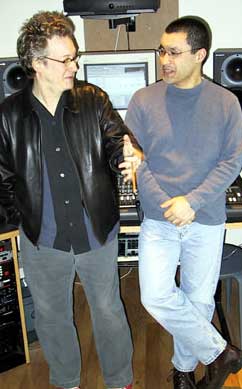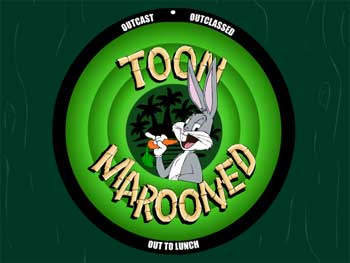|
 Composer/Producer
Jody Gray and Music Supervisor/Sound Designer Michael C. Lau of
New York based scoring house; Gray Noise Music, have discovered
that scoring music, creating sound design and mixing the final elements
for the Web using Macromedia's Flash medium, offers interesting
challenges. Composer/Producer
Jody Gray and Music Supervisor/Sound Designer Michael C. Lau of
New York based scoring house; Gray Noise Music, have discovered
that scoring music, creating sound design and mixing the final elements
for the Web using Macromedia's Flash medium, offers interesting
challenges.
It's been an
animated, "Stalling-esque" year for the company, (Gray
also composes the music for Cartoon Network's hit series, "Courage
the Cowardly Dog.") In March he scored, orchestrated and conducted
full orchestral open and closing themes for CN's "The Chuck
Jones Show" anthology series, using Carl Stalling's inspiring
work as a template. Outside of the usual strings and winds, the
ensemble featured yodeler, solo tuba and bass trombone, banjo and
accordion as well as techo -flavored loops. Lau's sound design brought
an awesome, edgy quality to the party, combining classic WB Sfx
with broad, post-modern flourishes.
Carl Stalling's
classic WB scores continue to define and influence music for animation.
So, when Warner Bros. Online approached the company to create original
music and sound design for twenty-six entirely new Looney Tunes
for the Web, they jumped at the chance.
But unlike
"normal" scoring there are synchronization issues inherent
in interactivity that need to be addressed.
Flash is not
a consistent, linear medium, where everything runs at 30 fps. It's
limited to the speed of the host computer running the shockwave
file (or swf). In most cases, Flash animation is set to 10-15 fps.
But on the average machine the lower frame rate can cause "jumpiness"
in the animation, due to the computer's unending struggle to keep
up. This is most apparent when audio is present and also dependent
on the complexity of the content.
With "Gotham
Girls," Gray Noise Music's first WBOL project the emphasis
was concentrated on creating small, 2-4 bar, easily loopable events.
Gradually these events became more daring. Although the loop scenario
is still a big part of what they do, it's more often about scoring
in a traditional, linear manner, although they deal with the final
result somewhat differently.
Audio can either
be set to 'stream' or play freely setting to 'event' or 'start'.
The former can cause the animation to drop frames, the latter allows
the audio and animation to run independently and not drop frames.
Because of
their vast TV experience, the team was used to scoring and creating
effects on a grand scale, lots of parts/elements with myriad accents
that need to be synched precisely to picture. In a linear medium
such as video (TV), it's relatively simple: you create a stereo
mix and lay it in. With Flash you must "break" the audio."
Music, for
example, must be split into separate parts. Any transitional swells
(cymbal and timpani rolls) used before or after a given cue are
mixed and made into a separate file. Drum loops are broken into
2-4 bar elements that can be looped until the scene is over. Any
instrumentation occurring over a loop is also mixed to a separate
file. This "breaking" up into primary elements allows
for a few things:
1) The audio
can be set to event/start and run independently while allowing the
animation to drop the least frames and to remain in synch, each
audio element is placed where it needs to synch up or start and
stop.
2) It grants
the animators the freedom to adjust the animation once the music
is approved and mixed, providing flexibility without having to re-score
or adjust.
3) Whether
set to stream or event/start, it allows the maximum amount of mixing
ability within the Flash application. This is especially useful
when you listen to the final MP3 compression and realize that something
needs to be louder.
There are additional
issues with Interactivity. Often each episode has more than one
ending and/or the viewer has the option of choosing a different
object to fall on Daffy, for example. Multiple versions of music
and sound effects must be created. But the biggest challenge is
making sure that the scored audio doesn't spill over into the next
scene, since that scene usually precedes the one the viewer selected.
In a sense, everything must be written and pieced together in a
modular, compartmentalized fashion.
Like the music,
the sound effects can also be extremely complex. Everything is layered.
An Sfx Pro Tools session can sometimes use 15 to 24 stereo tracks!
Many sound designers use samplers but the boys at Gray Noise find
that seeing the waveform, then chopping and placing it is the most
user-friendly way to work. Lots easier than doing it to a bunch
of samples in a sampler, let alone the loading time. Each effect
is usually 5-10 elements deep, for each part or action. There's
the attack, the body of the sound and the decay,
Panning each
element becomes challenging too, as only a few pan points are allowed.
For instance, in a long racecar scene, each car effect must be broken
out and panned separately to create the illusion of perception and
space.
 Once
sub-mixes are completed, the music and sound effects are recorded
into ProTools and mastered: the audio is run through Waves Renaissance
EQs and LI+ Maximizer. If "funking up" the audio is requested,
additional Pro Tools plug-ins are employed. All of the audio files
are bounced to stereo, 16 bit 441 kHz AIF files to be placed into
Flash. Once
sub-mixes are completed, the music and sound effects are recorded
into ProTools and mastered: the audio is run through Waves Renaissance
EQs and LI+ Maximizer. If "funking up" the audio is requested,
additional Pro Tools plug-ins are employed. All of the audio files
are bounced to stereo, 16 bit 441 kHz AIF files to be placed into
Flash.
Next the audio
is imported into Flash where the real mixing begins. Here the primary
elements are still separate allowing for level tweaking later. In
addition, the music and effects are set to stream or "event,"
whichever is appropriate for the action of the scene. When mixing
in Flash they always take into account any final VO tweaks and the
absence of VU meters or faders. All mixing is done with lines, and
each side, left or right, is moved independently. The final result
is 6-8 audio tracks in Flash.
Once all of
the audio is mixed and locked it's uploaded to a central FTP site
at WB, where Director Steve Belfer and animator Carlos Palazio make
any final animation and level tweaks. All audio, including the VO
is MP3 compressed. Generally, the VO and music are compressed at
a higher bit rate than the sound effects.
Steve and the
crew at WBOL continue to push the Flash envelope. It's rare to have
80MB Flash files, but they've set the bar very high. Flash was never
designed to handle files of this size, illustrated by the constant
crashes on the Mac version of the program once the files sizes balloon
past 50 MB.
In short, creating
music and sound design for Looney Tunes with Flash is much like
designing audio for video games, sans the surround element. It probably
won't be long before the creative minds at Warner Bros Online will
want to push that envelope as well. Hint, hint!
Contact
for more information
|